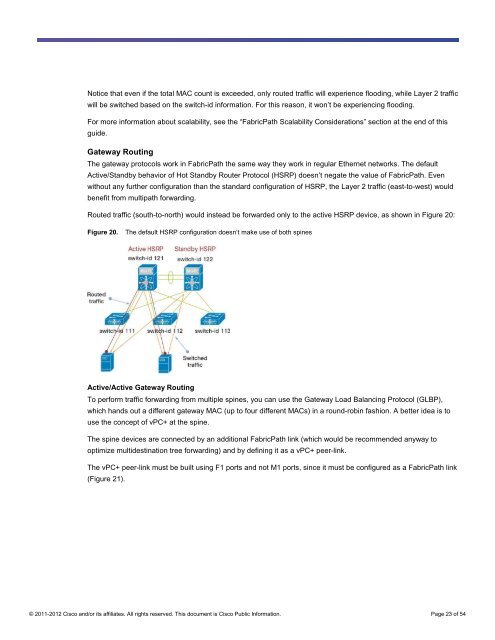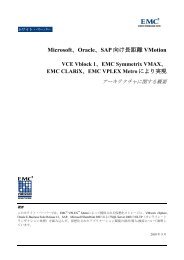guide_c07-690079
guide_c07-690079
guide_c07-690079
You also want an ePaper? Increase the reach of your titles
YUMPU automatically turns print PDFs into web optimized ePapers that Google loves.
Notice that even if the total MAC count is exceeded, only routed traffic will experience flooding, while Layer 2 traffic<br />
will be switched based on the switch-id information. For this reason, it won’t be experiencing flooding.<br />
For more information about scalability, see the “FabricPath Scalability Considerations” section at the end of this<br />
<strong>guide</strong>.<br />
Gateway Routing<br />
The gateway protocols work in FabricPath the same way they work in regular Ethernet networks. The default<br />
Active/Standby behavior of Hot Standby Router Protocol (HSRP) doesn’t negate the value of FabricPath. Even<br />
without any further configuration than the standard configuration of HSRP, the Layer 2 traffic (east-to-west) would<br />
benefit from multipath forwarding.<br />
Routed traffic (south-to-north) would instead be forwarded only to the active HSRP device, as shown in Figure 20:<br />
Figure 20. The default HSRP configuration doesn’t make use of both spines<br />
Active/Active Gateway Routing<br />
To perform traffic forwarding from multiple spines, you can use the Gateway Load Balancing Protocol (GLBP),<br />
which hands out a different gateway MAC (up to four different MACs) in a round-robin fashion. A better idea is to<br />
use the concept of vPC+ at the spine.<br />
The spine devices are connected by an additional FabricPath link (which would be recommended anyway to<br />
optimize multidestination tree forwarding) and by defining it as a vPC+ peer-link.<br />
The vPC+ peer-link must be built using F1 ports and not M1 ports, since it must be configured as a FabricPath link<br />
(Figure 21).<br />
© 2011-2012 Cisco and/or its affiliates. All rights reserved. This document is Cisco Public Information. Page 23 of 54



